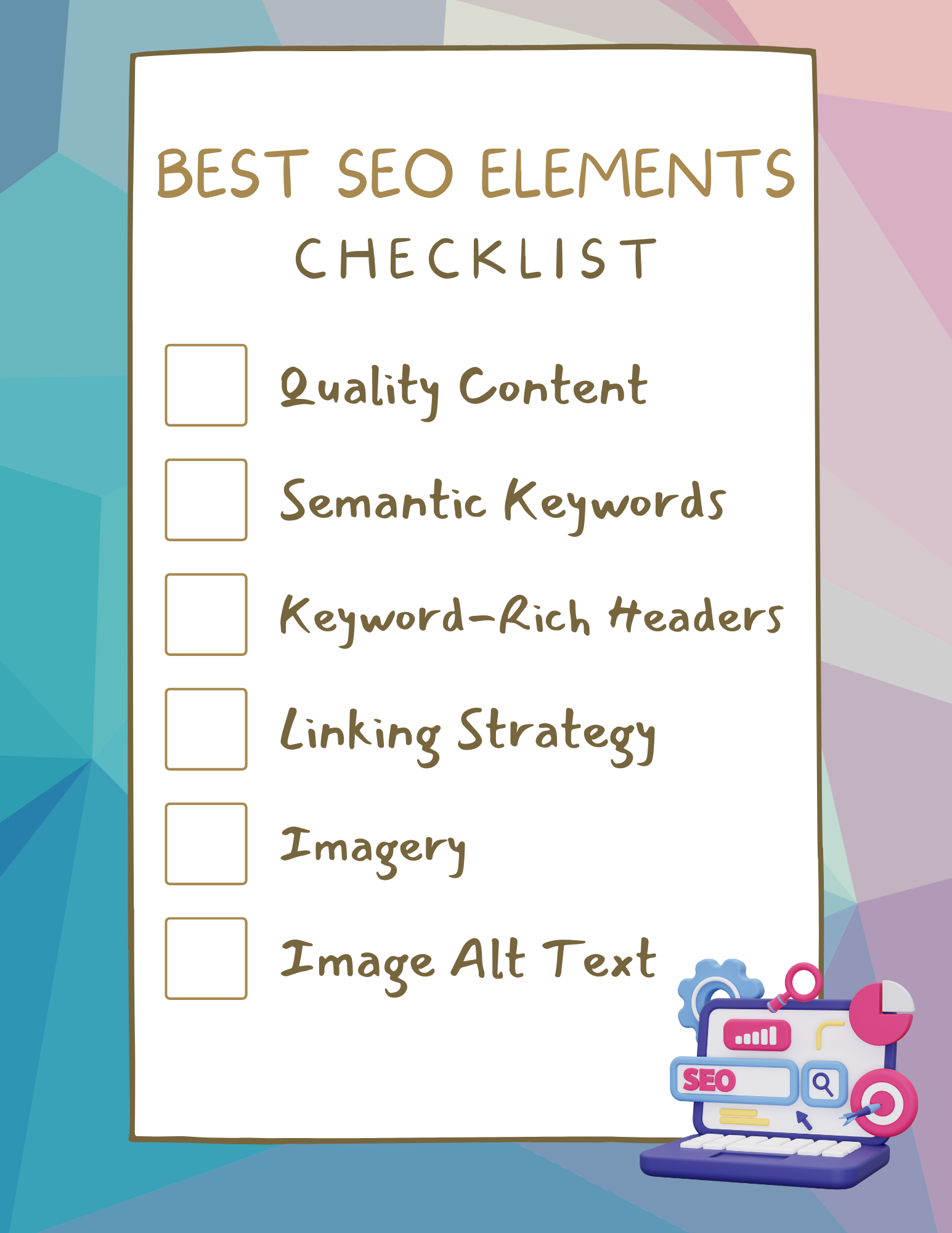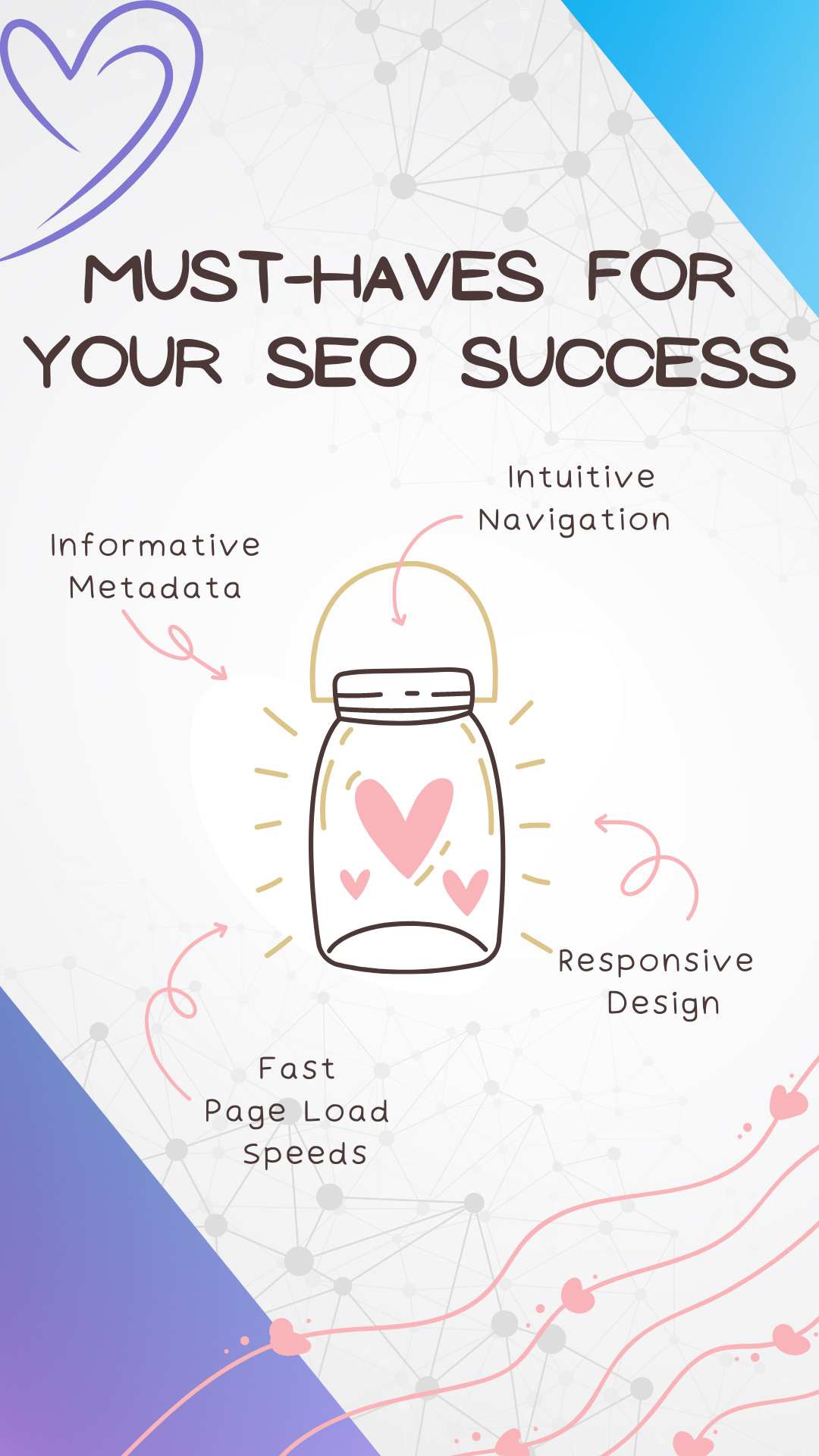
A well-crafted website allows you to connect with your customers and help them solve their everyday problems, like:
- What gear do I need while hiking with my dog?
- Where should I go on my next vacation?
- What’s the best guide to SEO in 2023?
No matter what questions your customers have, your website will be there to provide the answers and aid in the buyer’s journey.
But how do you get your website in front of those customers whenever questions arise? By infusing your website with all the best search engine optimization (SEO) elements.
While that might sound complicated, we’re here to make on-page SEO as easy as pie. To get started, simply use this guide on all the best SEO elements for your website.
Table of Contents
- What is SEO?
- Keyword Stuffing for the Win? Think Again
- Best On-Page SEO Elements for 2023
- Wait, Are There Any Other SEO Tactics to Consider?
- Achieve Inbound Marketing Success with Help from Jetura Media
What is SEO?
SEO, or search engine optimization, is all the things you need to do to help your website rank high on search engine results pages like Google. Quality SEO content, imagery, metadata, links, a responsive design, and more all come together to help increase the ranking of web pages targeting each keyword.
Since Google serves as the industry leader in this realm, on-page SEO best practices change often to align with their search ranking factor updates. Their updates always focus on the user experience above all else, making quality content a top consideration these days.
On-Page SEO vs Off-Page SEO
Search engines look at both on-page SEO elements and technical SEO factors to determine how to rank each web page on your site.
This ultimate guide to SEO primarily focuses on the most important on-page factors. Overall, these elements let the search engine know what your web page is all about and shows that it provides a great user experience.
Off page SEO reflects the trustworthiness and popularity of your website. These signals come from the activities of third-party websites and include:
- Backlinks: When you create quality content, other people will want to link to it, resulting in a nice collection of backlinks that boost your domain authority.
- Mentions: As your company grows in popularity, people will start talking about it and help Google understand that your brand is a trusted player in your industry.
- Google My Business: If you have a brick-and-mortar location, a Google My Business profile will help the search engine learn about your brand, resulting in improved local SEO results.
Create a great website and your off page SEO signals will improve, letting Google and other search engines know that your content serves as a helpful resource.
Why Care About Search Engine Optimization
When using Google search to find products, services, and general information, more than 75% of people only look at the links on the first page.
If the top-ranking websites on that page don’t answer their query in full, then off they go with another search.
You need to have results on the first page for many of the top industry-specific queries or you can forget about boosting traffic to your website.
The more keywords you can address with quality content, the more people you’ll get coming to your site.
Remember that you want to answer all the questions your customers could have about your products and services. Or you could lose visitors to your competitors.
Covering all the top keywords for your industry does take time, however. And it’s difficult to rank high for the most popular keywords before your off page SEO improves and starts picking up the slack.
So, you’ll have to settle for small wins at first. But your efforts will definitely pay off as you keep working at it.
Keyword Stuffing for the Win? Think Again

In the past, you could just stuff all your content with the target keyword and get great results.
Your web pages would rank high on the first search result page as Google only looked at relevancy back then. As their focus shifted to the user experience, however, that practice went to the wayside, and for good reason.
Keyword-stuffed content really bums people out because it rarely focuses on satisfying the query and guiding them through the buyer’s journey.
Nowadays, your web pages need to answer the query in full and provide an excellent user experience.
Your content should inspire your visitors to finish their buyer’s journey with your brand. Plus, it should make them feel thrilled to come back again in the future.
Beyond that, your website should have the resource page content your customers need to enjoy their purchases to the fullest through the years.
As for the keywords? They’re naturally infused in the content to reflect how you would speak about the topic.
Google wants you to focus on creating helpful content, not try to trick their robots with an overload of relevant keywords.
Best On-Page SEO Elements for 2023
To help your website reach the right people, you need to create excellent content with all the best SEO elements.
Sound too easy? Well, it really is that simple. But it’s not at all easy if you don’t know what you’re doing.
Thankfully, we’re here to help with a look at all the leading search engine optimization elements for your website. Here’s what you’ll need.

Quality Content
Quality is key if you want to rank high on the search engine results pages for each keyword you target.
For the best results from your SEO efforts, you need to answer the query better than everyone else on the first page while providing the best user experience possible.
To do that, you have to think about search intent by asking:
- Why would anyone search for this term?
- What goals do they want to achieve?
- How can your brand help them most?
Essentially, to reach your customers, you need to know what they’re looking for and deliver it.
Beyond that, your content needs to be easy to read and understand. Also, focus on making it scannable by using well-labeled headers and small paragraphs.
Don’t forget to keep people reading by wrapping accurate content in an entertaining, eye-opening, or otherwise enticing package.
Semantic Keywords
Keywords still help search engines understand the content on each web page. The big difference is that the algorithm Google uses now looks beyond the target word or phrase for semantic keywords as well.
So, instead of just using the exact keyword throughout your content, you want to let semantic keywords do the heavy lifting.
Also known as latent semantic indexing, or LSI, keywords, these words and phrases closely relate to the target keyword.
If your keyword is “inbound marketing,” semantically-related terms may include “content marketing,” “SEO,” “blog,” “digital marketing strategy,” and “content strategy.” You might see these terms used together while looking in your favorite keyword research tool, visiting competitors’ websites, or reading industry-related articles.
Essentially, LSI keywords are all the words and phrases that would come up in conversation while talking about the subject. Unsure what those might be? Use an natural language processing SEO tool like Clearscope to figure it out.
When done correctly, fully addressing the query at hand will result in all the related terms naturally landing on the page.
Just skip the urge to add the target keyword too much. Whenever possible, aim to just put it in the H1 header, one H2 header, and once every 250 to 500 words in the main body content.
Keyword-Rich Headers
Keyword-rich headers are a must for both your website visitors and search engine crawlers.
As far as your customers go, well-defined headers allow them to understand what each section is all about. Plus, if they’re in a hurry, they can use the headers to scan the content for the info they need at that moment.
Search engine crawlers use the headers to look at the content hierarchy and understand the purpose of your web page.
You cannot just write a heading and subheadings and call it good, however. You must use header tags to format the content.
To do that, just format the main title with an H1 header, telling people and search engine robots alike the main theme of the page.
Then, use H2 header tags for the main subhead throughout the content. If you want to break down the content even more, put H3, H4, H5, and H6 tags to work in organizing the rest of your content sections.
Linking Strategy
Links within your SEO content help search engine bots crawl through your website and understand the purpose of each page. So, you need to include them on all your web pages and blog posts.
The two main types of links you have control over are internal and external links.
- Internal: Links that navigate to other relevant web pages on your own website
- External: Links that send users to authoritative pages that relate to the subject
Every piece of content you create should have both of these types of links. You need to be careful not to overdo it, however.
Google may crawl over 100 links on every page, but your customers won’t find link-heavy content all that readable.
To strike a happy medium, only link to content that you feel your visitors would find helpful. Also, limit the internal and external links to three each for every 750 words of content.
Imagery
Imagery helps visitors to your site stay engaged with the content and keep reading through to the end. The images also help readers better understand the content, adding value to the user experience as a result.
Although stock photos will do in a pinch, custom works are even more effective. Think: Screenshots, graphs and charts, illustrations, 3D renders, GIFs, and your own photographs.
Want to go one step further? Add an interesting infographic that sums up your main points. Then, dive deep into the subject with your content to add more of that SEO mojo.
Image Alt Text
Always fill out the alt text for each image in your content with a focus on accessibility, not SEO.
If you can add keywords to the alt text while still explaining the image, great. But if not, just skip it and focus on creating an accurate description instead.
The alt text helps people with screen readers explore your site in full, so it’s important to keep the descriptions accurate to what’s in the photo above all else.
Do it right and search engines will still use the image data to determine if it adds value to the page and helps answer the search query.
Beyond that, the alt text allows your page to show up in image searches and further promote your content that way.
When you focus on all these top SEO elements, it’s easy to get your site to perform how you want. But that doesn’t mean it won’t take time.
Search engines don’t crawl websites on a set schedule and backlinks take a while to come in.
So, just treat your site like a work in progress and watch in awe as you start moving ever closer to achieving your goals.
Wait, Are There Any Other SEO Tactics to Consider?
You can put all the on-page SEO elements in place and still get poor results if your website is not set up for success. Fortunately, that’s relatively simple to fix by addressing these four factors.

Navigation
As search engine crawlers land on your site, they use the navigation links to understand the hierarchy of your site. Your website visitors do the same thing in hopes that your navigation will provide an intuitive browsing experience.
If your navigation links fail to send people and robots alike where they expect, then it could impact your ability to rank high with all of your content. Nip that problem in the bud by reflecting on the usefulness of your navigation menus.
Have any doubts about how your website navigation works for the end user? Perform user testing to verify that all your links lead to the expected spots – and check for any gaps in your navigation.
Responsive Design
People are using their smartphones to perform web searches more than ever before.
In fact, over 60% of organic searches occur on a mobile device, making a responsive web design a top priority for companies like yours.
Responsive web designs automatically resize the page to fit just right on all screens so that your frames, page layout, images, content, and more all show up as intended.
With that, you let your visitors enjoy a seamless browsing experience with your brand whether they’re on the go or comfy at home.
Page Load Speed
Just ask anyone: Life is busier than ever, and no one has the time to sit and wait for web pages to load.
Too many seconds pass without a response and they’re off to the next web result, hoping for a better user experience.
So, according to off-page SEO rules, you must have the fastest-loading web pages to avoid losing customers to your competition.
The goal? Just three seconds of loading for most web pages. If you have an eCommerce site, then make that goal two seconds and not a millisecond slower.
If you’d like to see how fast your pages load, Google Search Console can provide the details for each URL.
Metadata
When search engines display your web pages and blog posts on their results pages, they grab what they think is its title and a small excerpt from the page – unless you provide an alternative, that is.
Thankfully, that’s easy to do when using a website plug-in, like Yoast, to add a meta title and description.
By writing up your own metadata, you’ll control the narrative and accurately tell readers what they’ll gain from your post.
Furthermore, you’ll increase your click-through ratio by around 10% as readers can better decipher if the page will answer their search query.
When writing your meta title, remember to think up something different than the original title and keep it under 70 characters.
As for the description, sum up the blog post in 156 characters or less while keeping your visitors’ query and intentions in mind.
Remember to add in your main keyword, too, since that will help boost your search engine ranking for that query.
Achieve Inbound Marketing Success with Help from Jetura Media
SEO isn’t a one-time effort, but a continuous process that involves regularly updating your website with relevant content, researching keywords, and staying up-to-date with search engine algorithms.
As you put all the essential SEO ranking factors to work for you, more visitors might come to your site and complete their buyer’s journey with your brand.
Want help achieving all your inbound content marketing goals? Reach out to marie@jeturamedia.com to learn about our advanced on-page SEO services.
Our full-service content marketing support starts with a website audit, so you can see where you’re at and what SEO strategy will work best for your needs.
Then, we’ll create a service plan that uses the best SEO elements to take your website to the next level.
Just need a little help with your keyword research, content briefs, editorial calendars, and the like? We can do that, too. We’re also always happy to write high-performance SEO content for your website and blogs.

About the Author
Marie Abendroth is an experienced freelance writer and content strategist from Seattle, Washington. She enjoys helping people achieve their inbound marketing goals and grow their companies. In between projects, she’s driving her RC cars, playing video games, and spending time with her family.
